Hubungan Menonton Tayangan Video Ngaji Filsafat Akun Youtube MJS Channel dengan Respons Kebijaksanaan Viewers
DOI:
https://doi.org/10.18592/alhadharah.v21i2.7513Keywords:
Da'wah, new media, ngaji filsafat, youtube, wisdomAbstract
The purpose of this study is to quantify whether or not there is a significant relationship, as well as the nature of the relationship, between watching the Ngaji Filsafat Video Show on the MJS Channel Youtube Account and the Viewers’ Wisdom Response. This method of study employed a quantitative approach with survey techniques and a questionnaire instrument. The audience and fans of the Ngaji Filsafat video uploaded by the MJS Channel on YouTube comprised the population of this study. The Lemeshow formula was used to determine the number of samples, which resulted in 100 respondents. Simple random sampling was used in the sampling technique. According to the results of this study, there is a significant relationship between watching the Ngaji Filsafat Video Show on the MJS Channel Youtube Account and the Wisdom Response of the Viewers. The chi-square test between the two dimensions reveals a significant relationship at the 95% confidence level. Furthermore, through the Spearman-Rank test, it shows that the correlation of the total score of viewers' answers on the two variables measured using an ordinal scale turns out to be a value of 0.528 and shows significance at the 95% confidence level and the correlation level is strong and unidirectional. That is, the higher the size of watching the show for viewers, the higher the policy response of viewersReferences
Abidin, Yusuf Zainal. 2015. Metode Penelitian Komunikasi Penelitian Kuantitatif: Teori Dan Aplikasi. Bandung: CV. Pustaka Setia.
Aini, Aflah Zuhrotul. 2018. “Pengaruh E-Dakwah DAQU MOVIE Di YouTube Terhadap Peningkatan Pengetahuan Islam Pada Mahasiswa UINSA Surabaya.” STIKOSA AWS.
al, Morissan m.A,et. 2010. Teori Komunikasi Massa. p.t. Ghalia Indonesia.
Asy’ari, Hasyim. 2018. “Renaisans Eropa Dan Transmisi Keilmuan Islam Ke Eropa.” JUSPI: Jurnal Sejarah Peradaban Islam vol.2 (1): 1–14. http://dx.doi.org/10.30829/j.v2i1.1792.
Bungin, Burhan. 2013. Metode Penelitian Sosial & Ekonomi: Format-Format Kuantitatif Dan Kualitatif Untuk Studi Sosiologi, Kebijakan, Publik, Komunikasi, Manajemen, Dan Pemasara Edisi Pertama. Jakarta: Kencana Prenada Media Group.
Cooper, D.R dan Schindler P.S. n.d. Business Research Methods Ninth Edition. Mc Graw-Hill.
Hajar, Ibnu. 2018. “Youtube Sebagai Sarana Komunikasi Dakwah Di Kota Makassar (Analisis Sosial Media).” Jurnal Al-Khitabah V (2): 79–94.
Inc, We Are Social. 2022. “Kepois (We Are Digital) Indonesia Digital Report 2022.” New York.
Intani, Zahra Farida, and Aisah Indati. 2019. “Peranan Wisdom Terhadap Subjective Well-Being Pada Dewasa Awal.” Gadjah Mada Journal of Psychology (GamaJoP) 3 (3): 141–50. https://doi.org/10.22146/gamajop.44105.
Kurniawan, Dani. 2018. “Komunikasi Model Laswell Dan Stimulus-Organism-Response Dalam Mewujudkan Pembelajaran Menyenangkan.” Jurnal Komunikasi Pendidikan 2 (1): 60–68.
Lemeshow, Stanley, David Hosmer, Janelle Klar, and Stephen Kaggwa Lwanga. 1997. Besar Sampel Dalam Penelitian Kesehatan. Yogyakarta: Gajah Mada University.
Lesmana, Robby Putra Dwi, and Muhammad Syafiq. 2022. “Fanatisme Agama Dan Intoleransi Pada Pengguna Media Sosial.” Character : Jurnal Penelitian Psikologi 9 (3): 36–49.
Mufid, Muhamad. 2018. Etika Dan Filsafat Komunikasi. Depok: Prenadamedia Group.
Nuh, Sayid Muhammad. 2017. Dakwah Fardiyah. Solo: PT. Era Adicitra Intermedia.
Nurish, Amanah. 2019. “Dari Fanatisme Ke Ekstremisme: Ilusi, Kecemasan Dan Tindakan Kekerasan” 21 (1): 31–40.
Prakoso, Bayujati. 2020. “Message Acceptance of Ngaji Filsafat Preaching Through Instagram.” Diakom : Jurnal Media Dan Komunikasi 3 (1): 1–11. https://doi.org/10.17933/diakom.v3i1.71.
Rakhmat, Jalaluddin. 2012. Psikologi Komunikasi. Bandung: PT Remaja Rosdakarya.
Ramadhan R, and Destiana H. 2018. “Pengaruh Media Sosial Youtube Terhadap Perkembangan Dakwah Islam Dengan Metode Structural Equation Modeling(SEM).” Jurnal & Penelitian Teknik Informatika 1 (3): 60–66.
Renaldi, Muhammad. 2021. “Pesan-Pesan Dakwah Dr. Fahruddin Faiz Di Channel Youtube "Ngaji Filsafat.” UIN Antasari Banjarmasin.
Rosengren, Karl Erik. 2005. Media Effects and Beyond: Culture, Socialization and Lifestyles. Britania Raya: Taylor & Francis.
Sahrani, Riana. 2019. “Faktor-Faktor Karakteristik Kebijaksanaan Menurut Remaja.” Jurnal Psikologi Sosial 17 (1): 36–45. https://doi.org/10.7454/jps.2019.6.
Sarwono, Jonathan. 2006. Metode Penelitian Kuantitatif Dan Kualitatif. Yogyakarta: Graha Ilmu.
Sholikhudin, Anang. 2017. “Merebut Kembali Kejayaan Islam Analisis Internal Dan Eksternal Penyebab Kemunduran Islam.” Al-Murabbi: Jurnal Pendidikan Agama Islam 3 (1): 135–48.
Sugiyono. 2019. Statistika Untuk Penelitian. Bandung: CV. Alfabeta.
Sulaeman, A. R., Fazri, A., & Fairus, F. 2020. “Strategi Pemanfaatan Youtube Dalam Bidang Dakwah Oleh Ulama Aceh.” Communication 11 (1): 81–93. http://dx.doi.org/10.36080/comm.v11i1.1009.
Downloads
Published
How to Cite
Issue
Section
License
Authors retain copyright and grant the journal the right of first publication, with the work simultaneously licensed under the Creative Commons Attribution-NonCommercial 4.0 International Public License (CC BY-NC 4.0). This license allows reusers to distribute, remix, adapt, and build upon the material in any medium or format for noncommercial purposes only, provided that proper attribution is given to the original creator.







